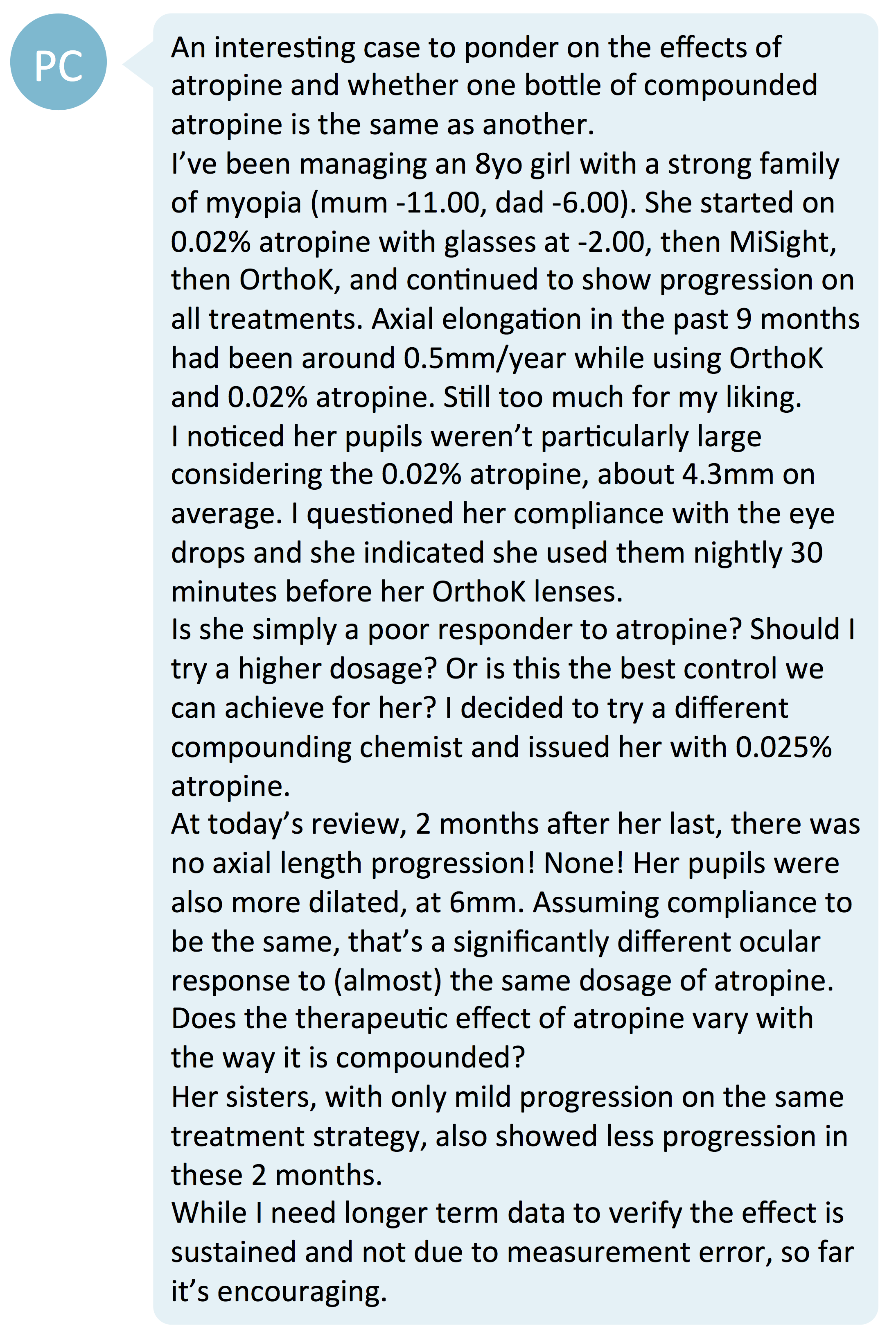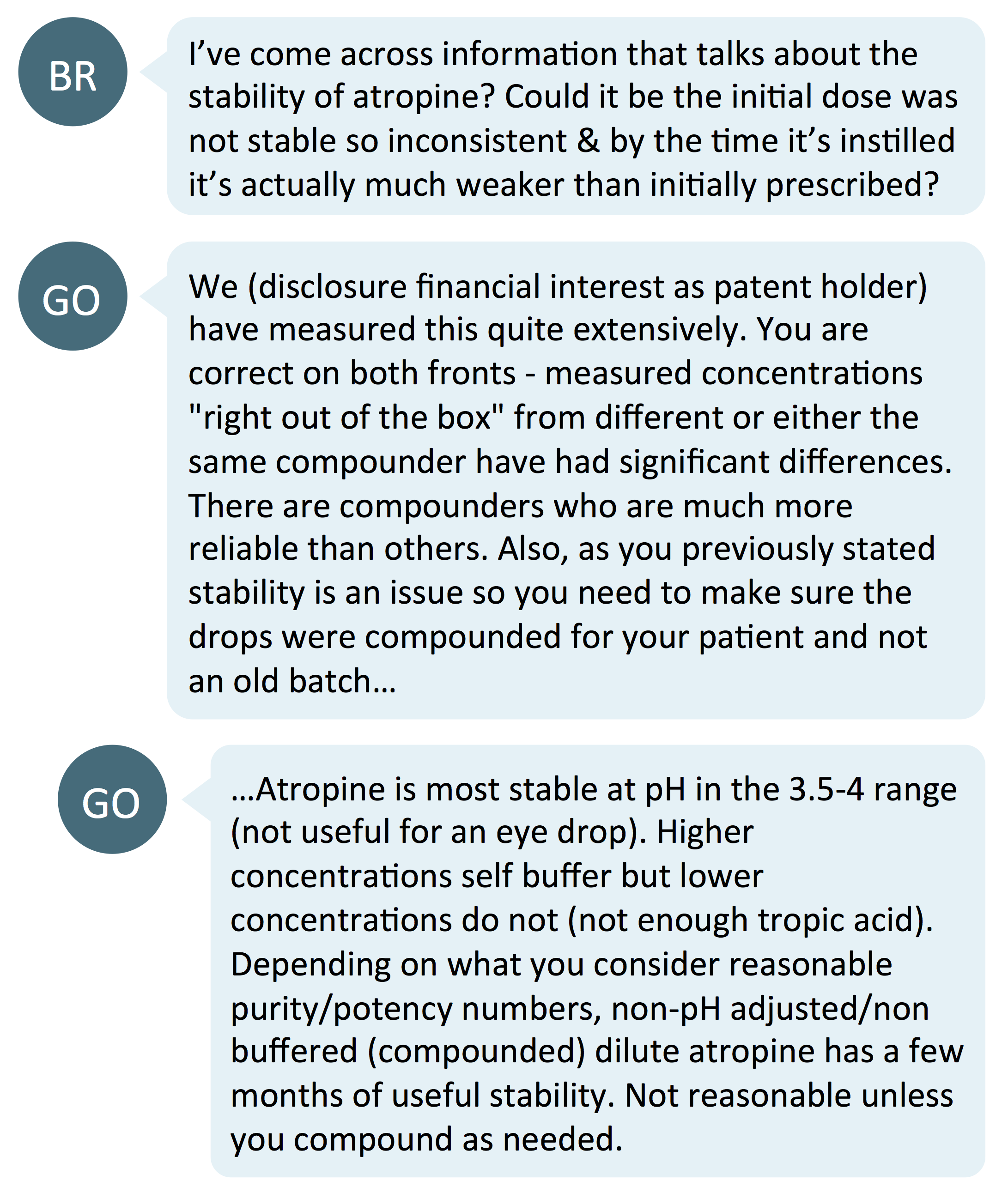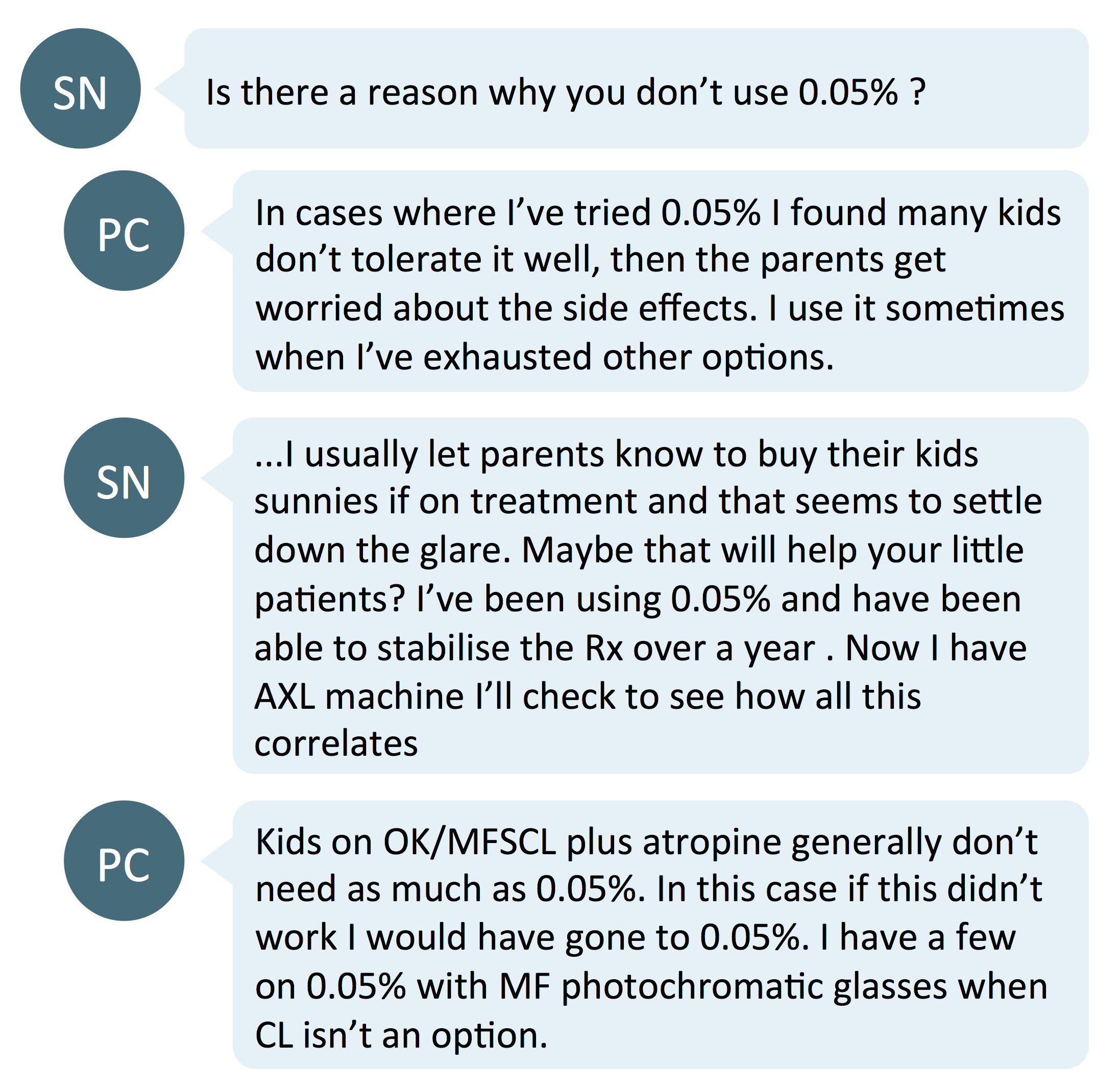Low-concentration atropine is not commercially available in most countries at present. Hence, prescriptions for low-concentration atropine drops need to be compounded for each individual patient. Can the efficacy of compounded atropine drops differ from one compounded batch to the next? Here is a case from PC where a similar concentration of low-concentration atropine elicited variable side effects over time.

Compounded atropine: is it the same from bottle-to-bottle?

A second batch of low-concentration atropine, changing from 0.02% to 0.025%, led to an increase in pupil size of almost 2mm. It would not be expected to see such a change with a 0.005% increase in concentration, especially considering that both 0.025% and 0.05% had similar impact on pupil size in the LAMP Study.1
The stability of compounded atropine may play a role in this case. The preparation method, other components used, preservatives, pH, and temperature can affect its stability and shelf-life.2 You can read more about this in Compounded Atropine For Myopia Control: Safe And Effective Prescribing.
Is the observed axial growth normal?

In the CLEERE and SCORM studies, the ‘normal’ axial elongation of 8-year-old emmetropic children is 0.16mm/year and 0.22mm/year respectively.3,4 For progressing myopes, the COMET study showed that axial elongation was 0.3mm/year in children of the same age.5 This patient’s 0.5mm/year axial elongation, while undergoing various myopia control treatments, exceeds the average rate of progression in an untreated (single vision corrected) myope. Therefore it was reasonable of PC to consider this an unsatisfactory myopia control outcome and seek to alter treatment.
As highlighted by other commenters, it is impossible to know what this child's axial length progression could have been without myopia control treatment - whether it could have been much faster or similar. The average 'untreated' axial elongation of 0.3mm/year for an age-matched child is just that - an average. Children can fall above or below that average, but for those notably exceeding the average it is worth considering the most effective treatment.
Currently, there is no clear 'best' treatment, with the best in each category of "orthokeratology, soft multifocal contact lenses, spectacles and atropine showing similar effect with some caveats."6 With potentially different mechanisms of action, it could make sense to try different treatments to test for better efficacy, but there is no evidence base to support this. There is emerging evidence for combining atropine and orthokeratology which, in the short-term, appears to have greater efficacy to control axial elongation by an additional 0.09mm/year compared to orthokeratology alone.7
This patient appears to be on the most effective treatment possible, being orthokeratology combined with atropine. There is only one retrospective study on combining 0.025% atropine with orthokeratology,8 while most other studies have employed 0.01% in the combination.7 Read more about this in Combination Atropine Treatments: When More Is More.
Why not a higher concentration?

The comments suggest a higher concentration of atropine as the originally prescribed 0.02% compounded atropine did not have the intended myopia control effect. This is a reasonable suggestion, given that 0.05% atropine has been shown to have better efficacy than 0.025% when compared directly in the LAMP Study for up to 3 years, with a similar side effect profile.1
In this case, PC's prescription of a new batch of compounded 0.025% atropine produced the desired myopia control effect: in the short-term, appearing to be much more effective than the prior treatment of 0.02%. Since the small change in concentration is unlikely to have generated this contrasting clinical outcome, the question of consistency of the compounded medication(s) is fairly raised.
Take home messages:
- When a patient does not respond as expected to low-concentration atropine in a compounded formulation, question compliance first, as PC has done here. If compliance is good, consider that compounding can potentially introduce variability from bottle-to-bottle. To learn more about this and questions to ask your compounding pharmacist, read this clinical article: Compounded Atropine For Myopia Control: Safe And Effective Prescribing.
- Monitoring axial length growth can allow one to properly gauge treatment outcomes. Where a child's outcomes on myopia control treatment appear to be similar to the 'untreated' (single vision corrected) average for their age, this could reasonably be considered an unsatisfactory result, leading to a change in treatment strategy.
Learn more about topical atropine for myopia control
Check out these clinical cases

About Kimberley
Kimberley Ngu is a clinical optometrist from Perth, Australia, with experience in patient education programs, having practiced in both Australia and Singapore.

About Connie
Connie Gan is a clinical optometrist from Kedah, Malaysia, who provides comprehensive vision care for children and runs the myopia management service in her clinical practice.
This content is brought to you thanks to an unrestricted educational grant from

References
- Yam JC, Zhang XJ, Zhang Y, Wang YM, Tang SM, Li FF, Kam KW, Ko ST, Yip BHK, Young AL, Tham CC, Chen LJ, Pang CP. Three-Year Clinical Trial of Low-Concentration Atropine for Myopia Progression Study: Continued Versus Washout: Phase 3 Report. Ophthalmology. 2021 Oct 7:S0161-6420(21)00745-4. (link)
- Haywood A, Testa C, Glass B. Personalised medicines for eye care. Pharma – Optometry Australia (magazine). 2020;3:22-24.
- Mutti DO, Hayes JR, Mitchell GL, Jones LA, Moeschberger ML, Cotter SA, Kleinstein RN, Manny RE, Twelker JD, Zadnik K. Refractive error, axial length, and relative peripheral refractive error before and after the onset of myopia. Investigative ophthalmology & visual science. 2007 Jun 1;48(6):2510-9. (link)
- Rozema J, Dankert S, Iribarren R, Lanca C, Saw SM. Axial growth and lens power loss at myopia onset in Singaporean children. Investigative ophthalmology & visual science. 2019 Jul 1;60(8):3091-9. (link)
- Hou W, Norton TT, Hyman L, Gwiazda J; COMET Group. Axial Elongation in Myopic Children and its Association With Myopia Progression in the Correction of Myopia Evaluation Trial. Eye Contact Lens. 2018 Jul;44(4):248-259. (link)
- Brennan NA, Toubouti YM, Cheng X, Bullimore MA. Efficacy in myopia control. Prog Retin Eye Res. 2020 Nov 27:100923. (link)[link to Myopia Profile Science Review]
- Gao C, Wan S, Zhang Y, Han J. The efficacy of atropine combined with orthokeratology in slowing axial elongation of myopia children: a meta-analysis. Eye & Contact Lens. 2021 Feb 1;47(2):98-103. (link)
- Wan L, Wei C-C, Chen C, Chang C-Y, Lin C-J, Chen J, et al. The Synergistic Effects of Orthokeratology and Atropine in Slowing the Progression of Myopia. Journal of Clinical Medicine. 2018;(7):259. (link)










